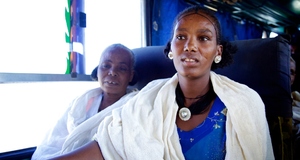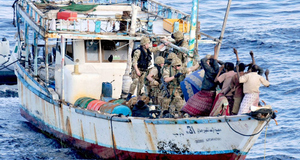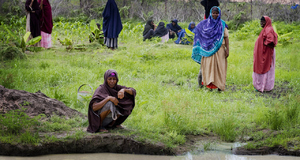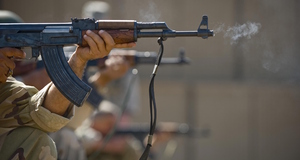Featured Article:The Horn of Africa: Critical Analysis of Conflict Management and Strategies for Success in the Horn's FutureSomalia: Siad Barre, Clan Opposition, and the Emergence of WarlordsIn complete contrast to Djibouti’s conflict management, Somalia shows little hope for resolution in the near future. In Somalia: A Country Study by Helen Chapin Metz, instability and conflict arose almost immediately following Somalia’s independence in 1960. Somalia’s second president was assassinated in 1969, and during the power vacuum that followed, the military staged a coup. Siad Barre was installed as the president of Somalia’s new government, the Supreme Revolutionary Council (SRC), which arrested members of the former government and banned all political parties. The National Assembly was also abolished, and the constitution suspended (1992 p. 2). Barre attempted to promote a stronger sense of nationalism by minimizing the importance of clan affiliation within government and civil society. If successful, he might have negated the ability of clans and sub-clans to undermine the rule of central government, but he succeeded only in instigating fierce opposition with various clan-based rebel groups. In an effort to quell opposition, Barre engaged in oppressive dictatorial rule, characterized by persecution, jailing and torture of political opponents and dissidents. The United Nations Development Program described "the 21-year regime of Siad Barre [as] one of the worst human rights records in Africa," (2001 p. 42). The Africa Watch Committee agreed, submitting, "both the urban population and nomads living in the countryside [were] subjected to summary killings, arbitrary arrest, detention in squalid conditions, torture, rape, crippling constraints on freedom of movement and expression and a pattern of psychological intimidation" (1990 p. 9).In an effort to incorporate various territories inhabited by Somalis into a Greater Somalia, Barre sent the Somali national army into the Ogaden in 1977. War subsequently broke out in the region, and the Somalis were initially successful, capturing much of the territory. When the Soviet Union shifted its support to Ethiopia and halted its supplies to Barre’s regime, the invasion abruptly ended and the Somali troops were forced out of the Ogaden by 1978. Following this event, Barre tore up his treaty with the Soviets and welcomed United States military and economic aid. This action ensured that his offensives would be adequately armed, and additionally facilitated the alliance swapping that occurred between Ethiopia, Somalia and the Cold War superpowers. Barre never gained control of the Ogaden, and in the early 1990s, his brutal dictatorship was overthrown. Warlord Mohamed Farrah Aidid and his rebel group, the United Somali Congress, invaded the country’s capital and fought government forces. Aidid ousted Barre in January 1991, and later declared himself President of Somalia in June 1995. Aidid’s government was not internationally recognized and his leadership was fiercely contested, particularly by Ali Mahdi Muhammad. H owever, Aidid and Mahdi were not the only figures vying for power. With an absence of established government, a power vacuum emerged and all political and military leaders from Barre’s fallen regime took up arms, made available through the millions of dollars worth of weaponry provided by the Soviet Union and United States. Militias sprouted under the leadership of members of Barre’s fallen regime as well as that of the various clans. Clans had been a target of Barre’s regime; when the clans had a common enemy, they worked commonly. With that enemy fallen, their ideals began to clash, and each clan hungered to establish itself superior over the others. Warlords emerged from the ranks of the former military and also through the endorsement of clan elders and sub-clan leaders. The number of warlords is as numerous as the various freedom movements they lead: Botan Ise Alin and the Somali Transitional Government, Osman Hassan Ali Atto and the Somali National Alliance, Mohamed Omar Habeb and the Somali Reconciliation and Restoration Council, Hussein Mohamed Farrah, former U.S. Marine and replacement for father Aidid as president, Omar Muhamoud Finnish and Muse Sudi Yalahow of the joined United Somali Congress/Somali Salvation Alliance, Abdi Hasan Awale and the Somali National Alliance, Aaden Saransoor Rahanweyn and the Resistance Army, just to name a few. Internal conflict in Somalia follows a similar pattern to its conflict with Ethiopia; there is no clear stalemate in the region, no representative that conflicting parties consider valid. Power-sharing has been unsuccessful and anarchy threatens to tear the nation apart. The social fabric of Somalia has been so fractured by the various clan alliances, public support, and secret international interests in different liberation groups and ideological organizations that no single entity has emerged as the predominant power in Somalia. Since the fall of Barre, Somalia’s only constant is general lawlessness, aggravated by famine and disease. A vicious cycle of resistance continues, and no one is a viable candidate for conciliation. NEW DIMENSIONS OF CONFLICTConflict in the Horn follows general patterns: decolonization power struggles, independent consolidation, and liberation movements. Complicating matters further are disputes over poorly defined territory and civil rivalries over state power-structure. The new dimension to these conflicts, however, is Somalia’s status as a failed state.Somalia’s central government controls little more than a section of the national capital of Mogadishu. A separatist government controls the North, and rival warlords and clan leaders control the remainder of the country. This adds a unique dynamic to conflict resolution in the region because, quite simply, how do you mediate domestic anarchy? Efforts were undertaken by the international community to establish peace, but intervention was met with disaster when the United Nations and United States implemented peace enforcement rather than peacekeeping. UN Intervention and the U.S. DebacleIn 1992 the United Nations Security Council passed Resolution 794 which overrode the principle of non-interference with domestic affairs on the legal grounds that Somalia’s conflicts endangered international peace and security. The text demanded that “all parties, movements, and factions in Somalia desist from all breaches of international humanitarian law” and confirmed the deployment of 3,500 UN personnel while “welcom[ing] any member state to establish an operation to create a secure environment [and any other] member state to participate in that operation,” (Res 794). This resolution was necessary after the cessation of central government resulted in multiple rival militias. The skirmishes between those militias, combined with drought, disrupted the nation’s food supplies. Famine decimated Somalia, killing more than 300,000 people. Endorsed by the United Nations, the Bush Sr. administration sent 30,000 troops to Somalia to assist in the distribution of supplies and aid. Somali response to United States aid was mixed. While many Somalis were grateful for the supplies, others expressed skepticism and distrust of the United States, which previously supported the hated dictator, Siad Barre. Skepticism was fair; the United States did not merely provide aid. In what is known as mission creep, the U.S. role included disarmament of various warlords, resulting in armed engagements that were often in urban environments. The most famous of these engagements led to the death of 18 U.S. marines and army rangers, as well as 1000 Somalis, popularized in the book and movie, Black Hawk Down. In 1993, the United States transferred the failing mission to the United Nations, also distrusted by Somalis because the UN Secretary General, Boutros Boutros-Ghali, also previously supported Barre. The United Nations shocked the world when they left Somalia, still leaderless, one year after the Clinton administration recalled all U.S. troops from the region in 1994. Somalia continues to spiral; internal conflict persists due to the distrust and competition between the country’s network of clans, sub-clans, and warlords. One of the greatest challenges to conflict management is this very entrenched clan system that can easily break down into sub-clan rivalries. Several peace conferences have been called in an effort to bring rival clans and militias to agreements, but this fundamental issue continues to cause peace efforts to fail because groups are left out or their legitimacy is undermined. Mediation is challenged by the task of establishing reconciliation, and power sharing continues to occur. The latter almost always fails once party goals are compromised; in Somalia, the mentality prevails that only complete subjugation of one’s opponent through violence indicates successful resolution.Continued on Next Page » Suggested Reading from Inquiries Journal
Inquiries Journal provides undergraduate and graduate students around the world a platform for the wide dissemination of academic work over a range of core disciplines. Representing the work of students from hundreds of institutions around the globe, Inquiries Journal's large database of academic articles is completely free. Learn more | Blog | Submit Latest in International Affairs |


















